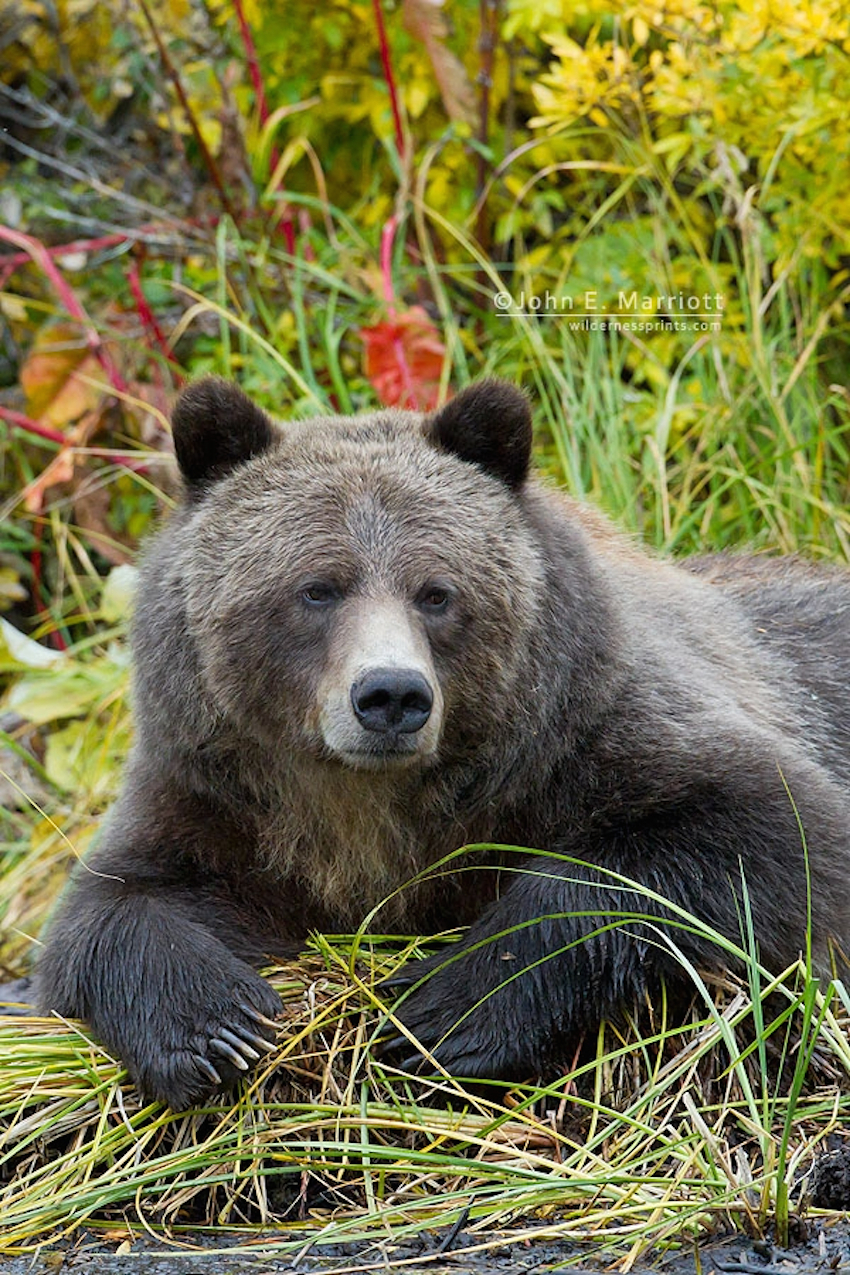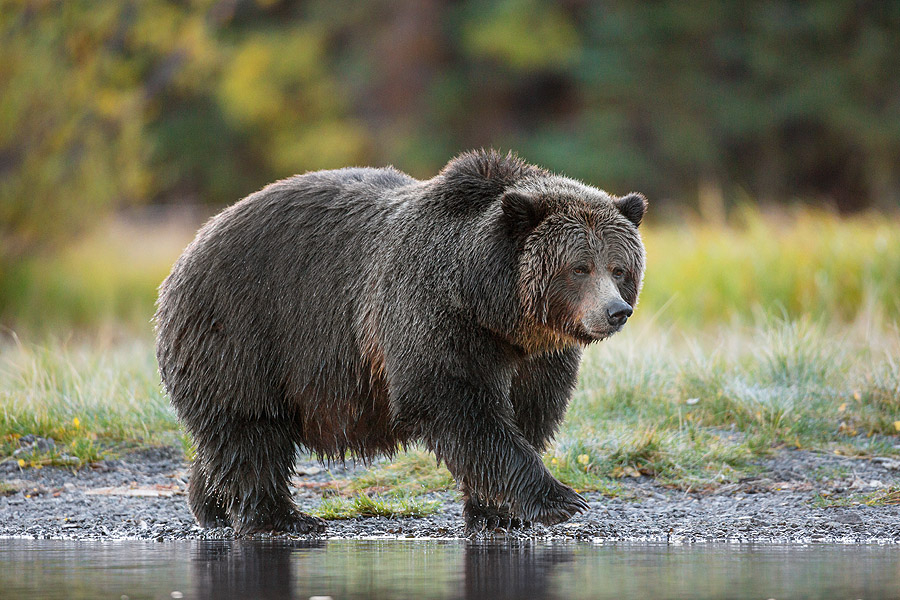Did one of interior B.C.'s favourite grizzly bears die following a Liberal government push to reopen the trophy hunt against 95% local opposition?
Sauntering down the banks of one of Chilcotin's many azure-blue rivers in B.C.’s interior for years has been an unusually large and heavy female grizzly that wildlife photographers have affectionately named “Big Momma.” Her inches-thick fur and unlimited fish appetite have made her a favourite to shoot —not with rifles, but with cameras. “Super gentle —an absolutely beautiful bear. And very, very big,” laughed John E. Marriott, a photographer from Canmore, AB, who has been guiding other photographers to the Chilcotin area since 2009. "We had two experienced biologists in there who thought she was a male by her girth. She’s always been a thrill for my clients.” Big Momma has been photographed thousands of times. She wobbles in with her cubs each autumn for the tasty salmon at the top of the Fraser watershed. She seems indifferent to the homo sapiens feverishly clicking DLSRs through long lenses across the river, says Marriott. She almost poses. “Very accommodating. She laid out in a marsh in the grasses in the clear view of our photographers." “After 30 minutes… we left her alone and went for lunch. When we came back two hours later, and she’d still be there. That’s telling we had no impact on her,” he added.
Big Momma not seen in 2014
But last year, for some reason, Big Momma disappeared. After being a regular for four years, Marriott says she did not reappear in 2014. That was the same year, B.C. Liberals reopened two wildlife management areas near her feeding location in the spring. One of the areas was previously off limits to hunters for 13 years due to over kills. Conservationists say the area was becoming a sanctuary, drawing grizzlies from hundreds of kilometres. Marriot now suspects a hunter may have shot her. Her estimated 700-pound body would’ve made too tempting a target for a hunter eyeing her for a floor hide, a head mount or just a good ol’ hunting story, he says. 
The "Big Momma" grizzly bear mother in the Chilcotin area of B.C.'s interior in 2010. Photo by John E. Marriot.
“Right when bear watching becomes a big thing in the Chilcotin, they open up the hunt,” he said. “It’s frustrating as a business owner running up against the [province], which is hurting my bottom line." According to Freedom of Information (FOI) released provincial emails, the BC Liberal government reopened the hunt in the Cariboo Chilcotin against overwhelming opposition — even in the local area. Of the 185 public comments registered with the regional wildlife office, a whopping 95 per cent said keep the rifles uncocked. The FOI email trail also shows long-time hunting advocate Liberal Mining Minister Bill Bennett — a former guide outfitting investor — was given a high-level briefing two weeks before the trigger was pulled to re-open the hunt. Another government email shows the province’s count to justify the hunt in the Chilcotin wasn’t a count at all: rather, it was a bet guess based on models and opinion. The nearby St’at’imc Nation told government they were perplexed by the sudden "doubling" of bears numbers. Provincial bureaucrats also mused that an uptick in bear numbers might benefit a proposed mine in the Chilcotin, memos show. Before the hunt reopened, University of Victoria Hakai-Raincoast bear biologist Chris Darimont co-authored a peer-reviewed study critical of the reliability of the province’s bear count models. It got national and international press, but seemed to make no difference on B.C. policy. He said it was bad conservation practice to open the hunt on such shaky bear totals. Taking a closer look at Big Momma's photo, Darimont said: "She is a baby-making machine. She has genes that allow her to live well in this environment. But the data tells us one in three bears taken in the province are female, which is a big no-no.” "I wouldn’t be shocked if she's is dead,” the scientist added. 
The "Big Momma" grizzly bear mother (foreground) in the Chilcotin area of B.C.'s interior in 2010. . Photo by John E. Marriot.
Despite B.C. hunting guidelines and responsible guide outfitters advising hunters not to shoot the females, Darimont says several years of provincial grizzly kill data that he obtained show 33 per cent of hunters kill the females anyway. That's because from 200 metres away in a rifle scope, it can be hard to tell the bear's gender, he said. One of the telltale signs of motherhood —nearby cubs —can be absent, as they may have wandered off or be sleeping. The provincial government's large carnivore specialist, Tony Hamilton, admitted such concerns in an internal email: "The greatest vulnerability the hunting stakeholders have is their continued harvest of females, particularly younger females. It gets more and more difficult as the years go by to call those animals trophies and stay credible," said the government biologist in late 2013. There’s also money, ego and testosterone in the mix. Motivated foreign hunters can pay B.C. guides up to $50,000 to come bag one of the largest land predators on earth. Nearby Alberta has banned the grizzly hunt. “Hunters have very itchy trigger fingers. They pay a lot of money for this," said Darimont. Female grizzly kills are discouraged because they bear the responsibility for reproduction, and the official (and disputed) total of grizzlies is just 15,000 in all of B.C.’s vast wilderness. A century ago, they were an estimated 100,000. Wildlife managers thus monitor female kill ratios closely. The province said there was an adequate number of females in the Chilcotin when it permitted three kill licences in the area in 2014 as a first step toward re-opening the grizzly hunt. “Harvest levels are determined based on the best available science. The hunts were re-opened because grizzly population information and trends indicated that a limited hunt was sustainable,” said provincial spokesperson Greig Bethel. "If hunting or other grizzly mortality exceeds acceptable mortality limits, the hunt can be reduced or even completely closed, as has been done previously,” he added.
So was Big Momma shot?
The Vancouver Observer asked the provincial government for the grizzly kill data from last year. Hunters are required to register their kills. So the data, which includes gender and teeth samples, might show if Big Momma was among those taken down. But of the roughly 300 grizzlies legally slain across the province, and the three hunting authorizations in the Chilcotin, zero kills in the area were recorded. It’s possible the Big Momma died of natural causes — she was old. Or perhaps she just wandered somewhere else last year, despite being a regular up here. But a well-worn motto for problem bears in the region is “shoot, shovel and shut up.” 
The "Big Momma" grizzly bear mother in the Chilcotin area of B.C.'s interior in 2010. Photo by John E. Marriot.
The area’s Big Creek ranchers were among the tiny minority of public commentators pushing for the hunt’s re-opening, provincial records show. Some suspect Big Momma may have been shot and buried for straying too close to cattle. “I would not be surprised,” said Chilcotin leader, Chief Roger William, of the Xeni Gwet’in band. "Things like that happen in the Chilcotin… people talk about it, but there’s not enough evidence.” Making matters worse, grizzly kill licences for the Chilcotin were tripled to nine in 2015, the province confirmed. So even if Big Momma did survive, the odds of her getting shot dead this year just multiplied.
David Williams, the founder of a local non-profit, the Friends of the Nemaiah Valley, said the hunt's justification comes down to hunting votes for Liberals, including for the Forests, Lands and Natural Resources Minister in charge of the hunt.
"Minister Steve Thomson is a hunter, and is far too close to the guide outfitters. He’s not objective. He’s part of the problem,” said Williams.
"The idea of shooting [the grizzlies] is totally abhorrent. The grizzlies in the area are usually old, big and tough. [Hunters] don’t want that meat. They want the hide."
"If you want to talk dollars, a live bear is probably worth 10 times what a dead bear is. There’s a developing tourism industry, especially among First Nations," he added.
Are grizzlies so horribilis?
Karen McLean owns one of several eco-tourism lodges at in the Tsilhqot'in territories. She says the apex predator — with the species name Ursus arctos horribilis — isn’t so horrible after all. "We used to be like everybody else — ‘Oh my god, the grizzly bear is going to kill us. Then you see them come through your yard… we didn’t have any problems. If you respect them, they respect you." “The bears have gotten used to not being killed. They thought this valley was safe for getting berries. But the killing changes the behaviour fairly quick.” The province’s grizzly spring hunt opened last week on April 1. John Marriot will return to the Chilcotin in the fall to see the effect. "This year will be a telling year if the hunt has had an impact on things."



Comments